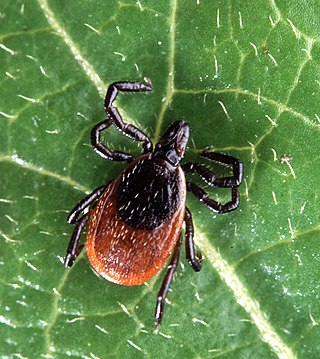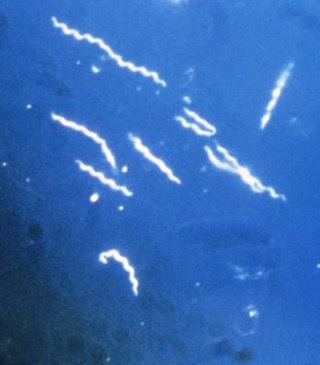
Lyme disease, also known as Lyme borreliosis, is a vector-borne disease caused by Borrelia bacteria, which are spread by ticks in the genus Ixodes. The most common sign of infection is an expanding red rash, known as erythema migrans (EM), which appears at the site of the tick bite about a week afterwards. The rash is typically neither itchy nor painful. Approximately 70–80% of infected people develop a rash. Early diagnosis can be difficult. Other early symptoms may include fever, headaches and tiredness. If untreated, symptoms may include loss of the ability to move one or both sides of the face, joint pains, severe headaches with neck stiffness or heart palpitations. Months to years later, repeated episodes of joint pain and swelling may occur. Occasionally, shooting pains or tingling in the arms and legs may develop. Despite appropriate treatment, about 10 to 20% of those affected develop joint pains, memory problems, and tiredness for at least six months.
Tick-borne diseases, which afflict humans and other animals, are caused by infectious agents transmitted by tick bites. They are caused by infection with a variety of pathogens, including rickettsia and other types of bacteria, viruses, and protozoa. The economic impact of tick-borne diseases is considered to be substantial in humans, and tick-borne diseases are estimated to affect ~80 % of cattle worldwide. Most of these pathogens require passage through vertebrate hosts as part of their life cycle. Tick-borne infections in humans, farm animals, and companion animals are primarily associated with wildlife animal reservoirs. many tick-borne infections in humans involve a complex cycle between wildlife animal reservoirs and tick vectors. The survival and transmission of these tick-borne viruses are closely linked to their interactions with tick vectors and host cells. These viruses are classified into different families, including Asfarviridae, Reoviridae, Rhabdoviridae, Orthomyxoviridae, Bunyaviridae, and Flaviviridae.

Borrelia burgdorferi is a bacterial species of the spirochete class in the genus Borrelia, and is one of the causative agents of Lyme disease in humans. Along with a few similar genospecies, some of which also cause Lyme disease, it makes up the species complex of Borrelia burgdorferi sensu lato. The complex currently comprises 20 accepted and 3 proposed genospecies. B. burgdorferi sensu stricto exists in North America and Eurasia and until 2016 was the only known cause of Lyme disease in North America. Borrelia species are Gram-negative.

Erythema migrans or erythema chronicum migrans is an expanding rash often seen in the early stage of Lyme disease, and can also be caused by southern tick-associated rash illness (STARI). It can appear anywhere from one day to one month after a tick bite. This rash does not represent an allergic reaction to the bite, but rather an actual skin infection of one of the Lyme bacteria species from the genus Borrelia. The rash's name comes from Neo-Latin for "migrating redness".

Dermacentor variabilis, also known as the American dog tick or wood tick, is a species of tick that is known to carry bacteria responsible for several diseases in humans, including Rocky Mountain spotted fever and tularemia. It is one of the best-known hard ticks. Diseases are spread when it sucks blood from the host. It may take several days for the host to experience symptoms.
Relapsing fever is a vector-borne disease caused by infection with certain bacteria in the genus Borrelia, which is transmitted through the bites of lice or soft-bodied ticks.

Borrelia is a genus of bacteria of the spirochete phylum. Several species cause Lyme disease, also called Lyme borreliosis, a zoonotic, vector-borne disease transmitted by ticks. Other species of Borrelia cause relapsing fever, and are transmitted by ticks or lice, depending on the species of bacteria. A few Borrelia species as Candidatus Borrelia mahuryensis harbor intermediate genetic features between Lyme disease and relapsing fever Borrelia. The genus is named after French biologist Amédée Borrel (1867–1936), who first documented the distinction between a species of Borrelia, B. anserina, and the other known type of spirochete at the time, Treponema pallidum. This bacterium must be viewed using dark-field microscopy, which make the cells appear white against a dark background. Borrelia species are grown in Barbour-Stoenner-Kelly medium. Of 52 known species of Borrelia, 20 are members of the Lyme disease group, 29 belong to the relapsing fever group, and two are members of a genetically distinct third group typically found in reptiles. A proposal has been made to split the Lyme disease group based on genetic diversity and move them to their own genus, Borelliella, but this change is not widely accepted. This bacterium uses hard and soft ticks and lice as vectors. Testing for the presence of the bacteria in a human includes two-tiered serological testing, including immunoassays and immunoblotting.

Arvid Afzelius (1857–1923) was a Swedish dermatologist.

Lyme disease, or borreliosis, is caused by spirochetal bacteria from the genus Borrelia, which has 52 known species. Three main species are the main causative agents of the disease in humans, while a number of others have been implicated as possibly pathogenic. Borrelia species in the species complex known to cause Lyme disease are collectively called Borrelia burgdorferisensu lato (s.l.) not to be confused with the single species in that complex Borrelia burgdorferi sensu stricto which is responsible for nearly all cases of Lyme disease in North America.

Ixodes scapularis is commonly known as the deer tick or black-legged tick, and in some parts of the US as the bear tick. It was also named Ixodes dammini until it was shown to be the same species in 1993. It is a hard-bodied tick found in the eastern and northern Midwest of the United States as well as in southeastern Canada. It is a vector for several diseases of animals, including humans and is known as the deer tick owing to its habit of parasitizing the white-tailed deer. It is also known to parasitize mice, lizards, migratory birds, etc. especially while the tick is in the larval or nymphal stage.

Ixodes ricinus, the castor bean tick, is a chiefly European species of hard-bodied tick. It may reach a length of 11 mm (0.43 in) when engorged with a blood meal, and can transmit both bacterial and viral pathogens such as the causative agents of Lyme disease and tick-borne encephalitis.

Human granulocytic anaplasmosis (HGA) is a tick-borne, infectious disease caused by Anaplasma phagocytophilum, an obligate intracellular bacterium that is typically transmitted to humans by ticks of the Ixodes ricinus species complex, including Ixodes scapularis and Ixodes pacificus in North America. These ticks also transmit Lyme disease and other tick-borne diseases.

Ixodes pacificus, the western black-legged tick, is a species of parasitic tick found on the western coast of North America. I. pacificus is a member of the family Ixodidae. It is the principal vector of Lyme disease in that region. I. pacificus typically feeds on lizards and small mammals therefore its rate of transmission of Lyme disease to humans is around 1% of adults. It is an ectoparasite that attaches itself to the outside of its host and feeds on the host's blood. It can have a heteroxenous lifestyle or monoxenous life cycle depending on how many hosts it feeds on in each cycle. I. pacificus has a four stage life cycle that takes around 3 years to complete. These stages include egg, larva, nymph, and adult. They prefer dense woodland habitats or areas of brush and tall grass.

Ixodes uriae, also known as the seabird tick, is a species of parasitic tick known to infest marine birds. It is native to many high latitude areas in the northern and southern hemispheres including Alaska, Canada, Faroe Islands, Iceland, Greenland, England, Scotland, Norway, Finland, the Kola Peninsula, Russia, Patagonia, South Africa and Australia.

Ornithodoros moubata, commonly known as the African hut tampan or the eyeless tampan, is a species of tick in the family Argasidae. It is an ectoparasite and vector of relapsing fever in humans, and African swine fever in pigs.
Borrelia miyamotoi is a bacterium of the spirochete phylum in the genus Borrelia. A zoonotic organism, B. miyamotoi can infect humans through the bite of several species of hard-shell Ixodes ticks, the same kind of ticks that spread B. burgdorferi, the causative bacterium of Lyme disease. Ixodes ticks are also the primary vector in the spread of babesiosis and anaplasmosis.
Borrelia garinii is a species of spirochete bacterium in the genus Borrelia. It is endemic to parts of Eurasia where it is one of the causative organisms of human Lyme disease. It is transmitted by hard-bodied ticks of the Ixodes genus, infecting various wild woodland mammals.
Borrelia spielmanii is a spirochete bacterium; it routinely infects Ixodes ricinus, and subsequently humans, causing Lyme disease.
Borrelia lusitaniae is a bacterium of the spirochete class of the genus Borrelia, which has a diderm (double-membrane) envelope. It is a part of the Borrelia burgdorferisensu lato genospecies and is a Gram-negative bacterium. B. lusitaniae is tick-borne; he type strain is PotiB2. It can be pathogenic, being involved in cases of Lyme borreliosis. A species of tick, Ixodes ricinus, is the host of B. lusitaniae. It is thought to have originated from Portugal and has since spread to parts of Europe and North Africa. Lizards of the family Lacertidae are now believed to be important reservoir hosts of this bacterium.
Borrelia mayonii is a Gram-negative, host-associated spirochete that is capable of causing Lyme disease. This organism can infect various vertebrate hosts such as humans via the bite of a black legged tick.










